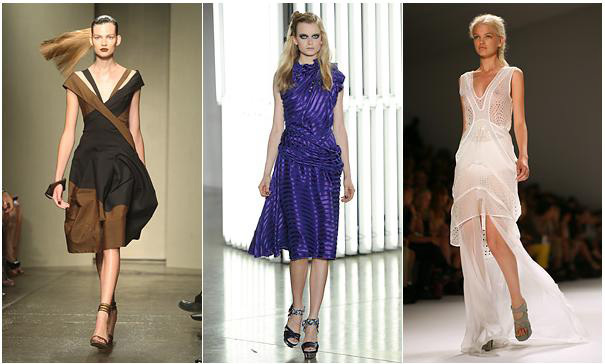The volume stays up
Updated: 2011-09-20 11:15
(The New York Times)
|
|||||||||||
 |
|
From left: Looks from Donna Karan, Rodarte and Vera Wang. [Photo/The New York Times] |
There seems to be no escape from the orgy of prints and color consuming the runways.
It continued on Tuesday at Rodarte and Vera Wang, with runny floral patterns. It struck on Monday with ice-cream pastels at Preen, tribal prints at Donna Karan and blazing red at Ohne Titel, where the prints resembled childish track marks. Maria Cornejo's prints looked as if something exploded in the kitchen; they were in fact digitalized blowups of Bolivian and African artifacts.
Americans don't know when to quit, but that's not the problem here.
Because all this intensity began a year ago in Europe with the super-saturated colors at Jil Sander, the monkey business at Prada and the neon lace from Christopher Kane, it will, in all likelihood, end there. That should be proof of their game-controlling superiority: they start a contagion and supply the antidote.
It's funny, though. Americans have been masters of color, from Warner Brothers to Warhol. Even if designers don't care for the brightness of animated cartoons, there is, as the late film critic Manny Farber noted, the equally important quality of gentleness that was mixed into the gags, particularly those of Chuck Jones.
That may be a tall order for fashion designers, who more often than not prefer the highfalutin to the familiar. But if you look at many of the prints that have appeared this week, and the way they were handled, you don't find that human dimension of wit and vulnerability. They don't make you smile.
Ms. Karan, who has been making trips to Haiti this year, said in her show notes that the tribal prints used for stretch cotton dresses and linen skirts were inspired by the Haitian artist Philippe Dodard. Mainly in browns and faded black, with burnt orange and violet, the motifs had a rough quality that suited Ms. Karan's urban aesthetic.
Anyway, they didn't come across as souvenir bric-a-brac — well, maybe a little. She was smart to offer designs that could stand on their own, among them body-hugging dresses in colorful pleated silk jersey. She showed a number of mask- and leaf-printed separates, in her sophisticated style, but the most uplifting pieces were the pinwheel skirts in linen and cotton. In recent seasons, Ms. Karan has gotten a little carried away with the drapery and the swoony glamour, maybe out of sheer boredom. This time, she found a natural outlet for her passions.
Spring is shaping up as another big dress season. Aside from below-the-knee lengths, the change is asymmetry and volume; the soft lantern shapes at Ohne Titel were in that vein. Maria Cornejo opened with a cropped off-white jacket shrugged over a hot yellow stretch dress, a combination that looks fresh. She said she also wanted to "toughen up" her summer clothes a bit. One way she did that was to drape a graphic print over a bright orange dress and run a belt through folds.
Tory Burch's first runway show was a sober, merchandised view of French loveliness, with crocheted Bermudas mixed with jersey stripes, gussied-up tweed, peony prints and chiffon evening dresses hitched to the shoulder with ties. You don't expect Ms. Burch ever to do anything that isn't polished, but sometimes you wish she would.
Beyoncé, decked out in a fitted jacket and a Tudor-style romper in cream chiffon from Vera Wang's spring collection, made her entrance just before the lights went up. Ms. Wang called her show "Alice in Wonderland," an appropriate bit of unoriginality. The rabbit hole she fell into was Balenciaga and Givenchy, right down to the strappy shoes, the perforated vests and the scooped-front skirts in near-naked white.
At least the Rodarte show planted a smile on your face. Beyoncé was there, too, in her romper. Maybe things have become so distorted that any reality seems possible, but I saw in the crinkly sunflower prints and blues not van Gogh, but rather a washed-out town in a film like "The Last Picture Show," with adolescent girls in too-old-for-them dresses with dropped waists and portrait necklines. The clothes were full of hope and lust, like a shabby rooming house, and were exaggerated in a good modern way with sofa-floral prints and reflective fabrics.